I've got an SCNCamera at position(30,30,30) with a SCNLookAtConstraint on an object located at position(0,0,0). I'm trying to get the camera to rotate around the object on an imaginary sphere using A UIPanGestureRecognizer, while maintaining the radius between the camera and the object. I'm assuming I should use Quaternion projections but my math knowledge in this area is abysmal. My known variables are x & y translation + the radius I am trying to keep. I've written the project in Swift but an answer in Objective-C would be equally accepted (Hopefully using a standard Cocoa Touch Framework).
Where:
private var cubeView : SCNView!;
private var cubeScene : SCNScene!;
private var cameraNode : SCNNode!;
Here's my code for setting the scene:
// setup the SCNView
cubeView = SCNView(frame: CGRectMake(0, 0, self.width(), 175));
cubeView.autoenablesDefaultLighting = YES;
self.addSubview(cubeView);
// setup the scene
cubeScene = SCNScene();
cubeView.scene = cubeScene;
// setup the camera
let camera = SCNCamera();
camera.usesOrthographicProjection = YES;
camera.orthographicScale = 9;
camera.zNear = 0;
camera.zFar = 100;
cameraNode = SCNNode();
cameraNode.camera = camera;
cameraNode.position = SCNVector3Make(30, 30, 30)
cubeScene.rootNode.addChildNode(cameraNode)
// setup a target object
let box = SCNBox(width: 10, height: 10, length: 10, chamferRadius: 0);
let boxNode = SCNNode(geometry: box)
cubeScene.rootNode.addChildNode(boxNode)
// put a constraint on the camera
let targetNode = SCNLookAtConstraint(target: boxNode);
targetNode.gimbalLockEnabled = YES;
cameraNode.constraints = [targetNode];
// add a gesture recogniser
let gesture = UIPanGestureRecognizer(target: self, action: "panDetected:");
cubeView.addGestureRecognizer(gesture);
And here is the code for the gesture recogniser handling:
private var position: CGPoint!;
internal func panDetected(gesture:UIPanGestureRecognizer) {
switch(gesture.state) {
case UIGestureRecognizerState.Began:
position = CGPointZero;
case UIGestureRecognizerState.Changed:
let aPosition = gesture.translationInView(cubeView);
let delta = CGPointMake(aPosition.x-position.x, aPosition.y-position.y);
// ??? no idea...
position = aPosition;
default:
break
}
}
Thanks!

